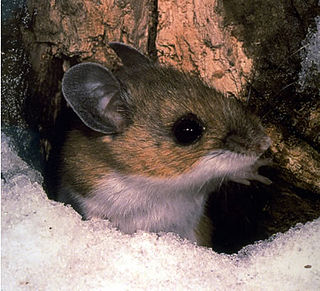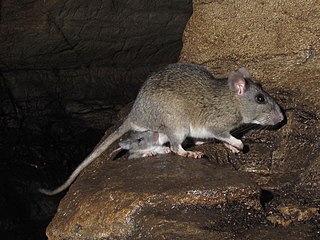
The desert woodrat is a species of pack rat native to desert regions of western North America.

The Neotominae are a subfamily of the family Cricetidae. They consist of four tribes, 16 genera, and many species of New World rats and mice, predominantly found in North America. Among them are the well-known deer mice, white-footed mice, packrats, and grasshopper mice.
A generalist species is able to thrive in a wide variety of environmental conditions and can make use of a variety of different resources. A specialist species can thrive only in a narrow range of environmental conditions or has a limited diet. Most organisms do not all fit neatly into either group, however. Some species are highly specialized, others less so, and some can tolerate many different environments. In other words, there is a continuum from highly specialized to broadly generalist species.

The eastern woodrat, also known as the Florida woodrat or bush rat, is a pack rat native to the central and Eastern United States. It constructs large dens that may serve as nests for many generations and stores food in outlying caches for the winter. While widespread and not uncommon, it has declined or disappeared in several areas.

The Allegheny woodrat, is a species of "pack rat" in the genus Neotoma. Once believed to be a subspecies of the eastern woodrat, extensive DNA analysis has proven it to be a distinct species.

The white-throated woodrat is a species of rodent in the family Cricetidae. It is found from central Mexico north to Utah and Colorado in the United States. It is primarily a western species in the United States, extending from central Texas west to southeastern California. Populations east of the Rio Grande in New Mexico and Trans-Pecos Texas, previously considered to be variants of the white-throated woodrat, have since 1988 been assigned to the white-toothed woodrat.
Anthony's woodrat is an extinct subspecies of Bryant's woodrat in the family Cricetidae. It was found only on Isla Todos Santos in Baja California, Mexico. It is thought to have been driven to extinction through predation from feral cats.

The dusky-footed woodrat is a species of nocturnal rodent in the family Cricetidae. They are commonly called "packrats" or "trade rats" and build large, domed dens that can reach several feet in height. Coyotes and other predators will attempt to prey on these rodents by laying waste to the dens, but the sheer volume of material is usually dissuasive. Occasionally, dusky-footed woodrats will build satellite dens in trees. Although these animals are solitary, except in the mating season, dens are frequently found in clusters of up to several dozen, forming rough "communities". The mating system in this species appears to be variable, with promiscuity most generally at high population densities and monogamy at lower densities.
Stephen's woodrat is a species of rodent in the family Cricetidae found in Arizona, New Mexico and Utah in the United States.

The California deermouse or California mouse is a species of rodent in the subfamily Neotominae in the family Cricetidae. It is the only species in the Peromyscus californicus species group. It is found in northwestern Mexico and central to southern California. It is the largest Peromyscus species in the United States.

Neotoma leucodon is a species of rodent in the family Cricetidae. Although originally named from San Luis Potosí, Mexico, as a species by Merriam, the white-toothed woodrat was long considered to be a synonym of the white-throated woodrat. Molecular data, however, indicate the populations east of the Rio Grande in New Mexico and Trans-Pecos Texas represent a different species than morphologically similar populations west of the river.

A pack rat or packrat, also called a woodrat or trade rat, are any species in the North and Central American rodent genus Neotoma. Pack rats have a rat-like appearance, with long tails, large ears, and large, black eyes. Pack rats are noticeably larger than deer mice, harvest mice, and grasshopper mice, and are usually somewhat larger than cotton rats.










